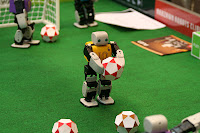 I am now in Boston, USA, to attend the IFAC TDS (Time Delay Systems) conference. From Tokyo to Boston, I flied with the Boeing 787 Dreamliner, which is a new airplane, entered commercial service on October 26, 2011.
I am now in Boston, USA, to attend the IFAC TDS (Time Delay Systems) conference. From Tokyo to Boston, I flied with the Boeing 787 Dreamliner, which is a new airplane, entered commercial service on October 26, 2011.The wikipedia entry reads:
The Boeing 787 Dreamliner is a long-range, mid-size wide-body, twin-engine jet airliner developed by Boeing Commercial Airplanes. It seats 210 to 290 passengers, depending on the variant. Boeing states that it is the company's most fuel-efficient airliner and the world's first major airliner to use composite materials for most of its construction. According to Boeing, the 787 consumes 20% less fuel than the similarly-sized 767. Its distinguishing features include a four-panel windshield, noise-reducing chevrons on its engine nacelles, and a smoother nose contour. The 787 shares a common type rating with the larger 777 twinjet, allowing qualified pilots to operate both models, due to related design features.An amazing thing is the cabin windows. For the windows, electrochromism-based "auto-dimming" (smart glass) is used instead of window shades, which reduces cabin glare while maintaining transparency. One can adjust the level of transparency with the key just below the window. I frequently changed the level before I got bored and fixed to the lowest level.
If you have a chance to come to Japan from Boston (or to Boston from Japan), you can get the experience!

.jpg)





